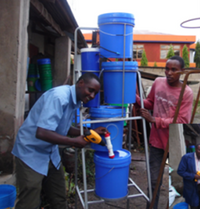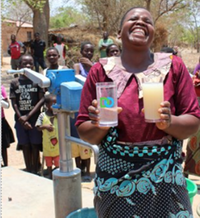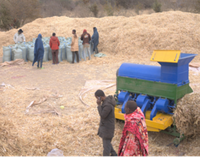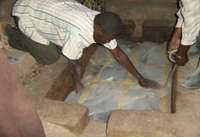At ECHO East Africa’s recent symposium on appropriate technologies and renewable energy, several presentations were shared by innovators proposing solutions to various challenges. These presentations can be found on www.echocommunity.org [http://edn.link/tzat23]. In order to encourage readers to explore these options, some are highlighted in this ECHO East Africa Note.
1. Pioneering Innovations in Water Technology
Water for domestic and productive use is one of the thematic areas that has drawn the attention of many ECHO network members. Based on the fact that many areas of the Horn of Africa are affected by prolonged drought, some for three years or more, new solutions for the use and management of water resources are highly needed.
Smart Irrigation: Reducing drudgery and efficient use of water for irrigation
A group of local engineers from a company called NEXTEC provide a solution for monitoring water use by an irrigation scheme operated remotely through mobile phones. By this idea, a farmer can use his/her mobile phone to send an SMS to the system at the farm soil sensor firstly to know if the field needs to be watered or not. If the system responds that watering is needed, then the farmer can send another SMS to switch on the pump. Similarly, through an SMS, the farmer can test if the field is wet enough and whether the pump needs to be stopped from watering. If the farmer is unsure whether the pump is running or not, he can ask and receive accurate information immediately, hence to operate the irrigation system remotely. Some of the benefits of this technology are: 1) saving time and transportation resources that would be used to operate the system physically, thus reducing running costs, 2) maintaining efficient use of limited water resources, and 3) as a way of monitoring soil moisture on the farm. For further information on how to acquire this technology in Tanzania, contact:+255 672 914 363; nextecengineers.group@gmail.com
Cleaning water through low cost filters - Nanofilters

Figure 1. Prof Askwar Hilonga (in blue shirt) demonstrating the installation of nonofilter at the community. Source: The Project Officer Nanofilter, Tanzania
Common among Africans living in rural areas, access to drinking water is limited, with the coverage for potable water reaching only some 45 percent of the population (Lars Kamer Mar. 13, 2023). According to Prof. Askwar Hilonga, in Tanzania, over 70% of the population is living without safe water. A Nanofilter is a water purification system that was invented by Askwar Hilonga, a professor at the Nelson Mandela African Institute of Technology (NM-AIST). It provides clean and safe water by removing bacteria and other microorganisms, excess Fluoride which affects teeth and bone development, as well as arsenic, both whose presence is in excess of toxic thresholds in water systems all along the African Rift Valley. These create widespread public health issues. The filter was evaluated by the World Health Organization (WHO) and has a performance of 99.9999%. It has contributed to the reduction of waterborne diseases in Arusha, Tanzania by 42.9% (according to one government report). The filter is sold to households and institutions like schools and hospitals at more affordable prices than imported filters. Through the technology, drinking water is cleansed from all impurities, bringing it to the level of international standards. Based on Prof. Hilonga’s presentation, his efforts have impacted more than 400,000 people by July 2023, creating jobs for 250 people through establishing 130 rural water stations, providing water in 116 institutions and more than 1,130 households. For further information on how to acquire this technology in Tanzania, contact: +255 787 303 091; hilonga@gmail.com; www.gongalimodel.com
Life Pumps by Greg Bixler

Figure 2. A lady in Malawi holding two glasses of water showing the difference of quality of water from the Design Outreach- Life Pumps source and the old source which was used by the community before the DO interventions. Source: Greg Bixler from Design Outreach
The story of the Life-Pump is a ‘God story’ combining faith, prayer, engineering, and an abundance mentality to help tackle the world’s water crisis by creating a durable, deep-reaching hand pump desperately needed in developing countries. This is being accomplished by using tools produced through a human-centered design process as its foundation. The Design Outreach Way of Appropriate Technology development was used to develop the idea for the Life-Pump. It started from a conversation between a couple of engineers and a long-term missionary from the Central African Republic. In his presentation Greg focuses on how quality pumps by not being subject to breakdowns can significantly reduce operational costs as well as maintain a good service of water supply to a community. Using a Life Cycle Costing Approach, which considers different categories of costs in the water utility, Greg’s experience shows that frequent breakdowns of water systems are sometimes costlier if the quality of the initial investment is compromised at the beginning. Greg’s session shares the process of appropriate technology development utilizing a Design Outreach (DO), from concept to a nationally accepted hand pump option in Malawi and Zambia. The process is being applied in other appropriate technology areas in water, sanitation and health (WASH) and for medical devices. Greg emphasizes the importance of a value proposition and Matthew 7:12 – the Golden Rule – in making decisions about requirements and what long-term sustainability means. As appropriate technology developers, the status quo is a strong competitor, but the story of the Life-Pump should inspire us into action and lead to global changes in community development by putting durability of options in the forefront. For further information on how to acquire this technology or to learn more from Greg, contact: +1-614-578-2623; Greg@doutreach.org,
2. Post-harvesting Technologies at the Small-scale Level
Agricultural producers across Africa suffer huge post-harvest losses in food products annually in the range of 30% in cereals, 50% in roots & tubers, and up to 70% in fruits and vegetables. The EAC Deputy Secretary General in charge of Productive and Social Sectors, Hon. Christophe Bazivamo, said that Partner states could reverse this situation through the deployment of better storage and processing technologies and enhanced packaging techniques. These all can greatly contribute to regional development objectives; ensuring food security and resulting in higher earnings for farmers and small to medium enterprises (SME).
Engineering Technology Hubs as promoted by the Centre for Agricultural Mechanization and Rural Technology (CAMARTEC) Tanzania

Figure 3. A photo showing one of threshing services provided by CAMARTEC Engineering Technology Hub (ETH)in Tanzania.
Source: Eng. Godfrey Mwinama
Sharing experiences during the August 2023 ECHO symposium, a presenter from CAMARTEC demonstrated the way Engineering Technology Hubs (ETHs) have promoted appropriate strategies to finance agro-processing for industry and small holders. The concept of ETHs involves technologies from various public and private institutions being established in one place within a community. Business models are introduced so as to enhance the uptake of the technologies. The services provided by the hubs include building participant skills and creating awareness about different technologies. Affordable prices are set for farmers in order to access the technologies either by hiring the equipment from the hub to do the work at their farms or bringing the crops to the hub. Individual farmers can also organize themselves and buy the equipment from the hub. Some of the achievements include employment of youth and women, reduced post-harvest losses due to better access of services, and promoting free marketing of technologies produced by local/private fabricators. See www.echocommunity.org for more information on this presentation or contact: +255 769 294 753; gmwinama@gmail.com
Airtight Underground Grain Storage.

Figure 4. Daniel Tewu (left), in Mchemwa village Dodoma, Tanzania enclosing sorghum with polythene sheet in the underground airtight grain store. Source: Kaleb Chomola, program Office from Diocese of Central Tanganyika (DCT) 2015
Grain has been stored in underground pits in North Africa and the Middle East for thousands of years. It is currently a common practice in Sudan, Somalia and Ethiopia. While underground storage pits have been in use since ancient times, they are still relatively unknown, but can be an attractive option for many. Storage pits offer the advantages of relative easy construction, low relative cost, safety from theft, good thermal insulation, and protection from moisture, rodent attack and insect infestation.
In many developing countries, grain production and storage play significant roles in food security with estimated 30%-40% losses of grains and pulses between field and mouth. Sorghum and maize are the main crops traditionally grown in many dry parts of Africa. At the ECHO East Africa symposium of August 2023, Mussa John Chilemu, a project officer of the Anglican Church of Tanzania (ACT) shared the diocese’s experience constructing affordable and secure underground air tight grain stores in communities both for household level and larger group storage centers. Community members in Dodoma are constructing these types of storage systems inside their houses or next door, so as to ensure security of their crops. There are several construction designs and costs differ accordingly. For more information on how to acquire this technology or to learn more from Mussa, contact: +755 334 647; musara2012@gmail.com
3. Moving Toward Entrepreneurship: Bridging the Gap between Technical Knowledge and Application for Small-Holder Farmers and Local Innovators
Introduction
Marylin Hokororo, a 55-year-old woman from Arusha, Tanzania was left to care for her 2 children, 3 grandchildren, and 5 young relatives after her husband’s death. She needed to find a means of income generation for her family and fast. What she had in her possession were two weaving looms and a little bit of hope. She produced cloth garments but found that they were unsatisfactory for her potential customer base, so that her hope soon ran out and she decided to forego her weaving business. As author Gary Thomas wrote, “Beauty is often birthed in struggle”, and indeed that was the case for Marylin. Read on to the end of this article to see how she resolved this.
Livinus Manyanga, founder of KAKUTE, a company promoting rural technology innovation, says entrepreneurship “is all about putting innovation to work. It is taking those [innovation] insights and making them real by assembling resources, building products and generating revenues.” For small-holder farmers and innovators in other fields, the challenge remains constant: getting their produce from the field and into a reliable market for a stable source of income. If they can meet the basic needs of their family through these means, then they can begin building their businesses.
Harold Msanya, Innovation Coordinator at ECHO East Africa further elaborates,
One of the challenges is that local innovators do not know how to be entrepreneurs even though it is just as important as creating innovations. Entrepreneurship has its own techniques. If a local innovator is not capable of knowing how to sell his or her technology, s/he better find a way of partnering with the people who know how.
So, how do we build bridges that meet people’s needs in a very practical, business-oriented, entrepreneurial-minded way? It’s not easy, but it is possible. This following article explores more:
Challenges from the Field
Recently, the author visited Twende, an Arusha-based non-profit organization and incubation station for local innovators. Upon reaching the back of the building, there lay before me a myriad of inventions. From a cassava processing machine to an automatic maize husker to a tire-made chair, I assumed these incredible innovations were actively being sold and improving people’s lives. When I asked Antony, the Workshop Manager, why they were just “sitting around,” he kindly responded, “It is because we lack the business and marketing skills to produce them at a larger scale.”
Yoonyoung Cho from the World Bank notes that low literacy and numeracy rates among entrepreneurs hinder their acquisition of new skills to develop business ventures, stating, “Unless these gaps are addressed first, training in advanced areas will not yield the desired impacts.” By understanding the language of business and knowing how to communicate with their customers, innovators are less likely to be taken advantage of by greedy middlemen. Unfortunately, this is not always the case.
ECHO Asia’s Impact Center Director, Patrick Trail, shared a grueling story at the annual conference in Thailand about this very issue (paraphrased):
I spoke with a farmer in a nearby village who said one of the biggest problems the farmers in his area faced was selling their goats at market for a good price. This is because their only means of transporting them was through a middleman saying, “He comes to our village and offers us an extremely low price for our livestock.” When I asked, “Why don’t you gather the other farmers together and demand better prices?” His response was, “We did! Then he gathered the other middlemen in the area, came back to our village, beat us up, and burned our barns down. He said to us, ‘Never do that again.’
What a sobering testimony of an honest attempt to build an entrepreneurial bridge. This story is all too common for people living in rural areas. How can this be changed for vulnerable communities? Charles Bonaventure of ECHO East Africa and Jimmy Ebong of Match-Maker Associates, Ltd. in their publication EAN Issue #3 suggest the need for smallholder farmers to be active members in managing the quality standards required of their products within the value chains because, “...it is easier to harness their willingness, cooperation and participation to work towards meeting the set parameters, and.they are able to benefit from premium prices, which the market is able to pay when the set standards are met, hence increasing their returns from chain participation.” By involving farmers in the distribution of their own value-added materials instead of shunning them, both farmers and consumers win and there becomes no need for the middlemen. The farmers have a voice. The same concept can be applied to local innovators like those from Twende. If only they have the marketing skills needed to mass-produce their machines, they can display their value to the public. That is where, as Cho from the World Bank says, “a comprehensive approach combining skills training with access to finance is more effective in helping small-scale entrepreneurs to succeed in the labor market than either service alone.”
Noteable Entrepreneurship Models
Our most recent symposium featured over 10 plenary speakers who shared their insights gained from valuable experiences in the field. Although there were new and exciting innovations presented such as the water filter made of nanomaterials, a gravity fed water pump, a water pump powered by wave action, and more, there is something to be said about meeting a greater need beyond the innovative technology itself. As Harold notes,
What we saw at the symposium was that we need to widen our network. We need not only innovators but to bring entrepreneurship to our technologies. Entrepreneurship has its own people. It’s a talent. Not everyone can be an entrepreneur. Maybe only 5% can be. We need entrepreneurship skills to guide the scale up of our ideas. Innovation cannot stand alone. We must bring innovators into business models, entrepreneurs to market innovators’ products. This is the role ECHO East Africa can play.
- Harold
What seems to be important in yielding better outcomes from business support programs is to incorporate appropriate pedagogical approaches and supplementary services for the poor and vulnerable,
- Yoonyoung Cho.
A Myanmar-based Entrepreneur Support Organization (ESO) developed by Matt Wallace has been transformational in the lives of many local people. From business training to one-on-one coaching sessions to financial support, this Southeast Asia-based organization has developed a unique platform for reaching and advising budding or seasoned business owners. Matt and his team contextualized their program to reach their target audience: a middle-aged woman who scrolls through her phone at the end of a long work day. Therefore, because they met their audience in the context of their socioeconomic and living situation by communicating features through a ESO’s app via internet, the program has grown rapidly. Indeed, in order to partner with others well Matt says there needs to be, “Best practices that bridge the gap between technological advancement and practical implementation.”
So, how can these principles in Asia apply to farmers and innovators in Africa? In Tanzania, “bridging the gap” may mean providing proven changes in marketing farmers’ products to consumers. One person told the author, “There are so many people selling tomatoes in the market right now, but if one of them would sell tomato sauce, how much more valuable would that be compared to their competitors?” In this case, hosting a food processing and handling seminar would be appropriate. ECHO East Africa Impact Center’s Maresha ox-drawn seeder business model includes hands-on-learning, open discussions, monitoring, and follow-up, all which are suitable methods for technology introduction for small-holder farmers.
An ECHO conference attendee made a wise observation on human nature, “Our natural drive is to go forward,” and added, “but sometimes we might be going in the wrong direction. It’s not right until it’s validated.” That’s exactly what Marilyn Hokororo from Afrikan Wear Designs did. She discovered her clientele desired a wider cloth, so she enlarged her weaving loom, and moved forward in the right direction. She changed her business model to address her customers’ preferences, and now she is teaching other young entrepreneurial women to do the same. See www.echocommunity.org for more information on this presentation or contact: +255 754662646
livinus.manyanga@kakute.org
References
Cho, Y. 2015. Entrepreneurship for the poor in developing countries. IZA World of Labor. https://wol.iza.org/articles/entrepreneurship-for-poor-in-developing-countries
Bonaventure, C. and J. Ebong. 2014. Linking Smale Scale Farmers to Markets through a Value Chain Approach and the Role of Information and Communications Technology. ECHO East Africa Note no. 3.
Water.org. n.d. Tanzania. https://water.org/our-impact/where-we-work/tanzania/